NorthWestern Energy Builds a Regulating Reserve Plant
Stable grid operation is challenging, especially when intermittent and unpredictable renewable generation is added to the generation mix. For NorthWestern Energy, the best solution was adding fast-acting gas-fired generation to its Montana electricity grid to meet required reliability standards while replacing expensive third-party contracts for ancillary services.
NorthWestern Energy’s (NWE’s) Dave Gates Generating Station (DGGS), formerly the Mill Creek Generating Station, was constructed as a “regulating reserve” plant to provide highly flexible reserve capacity for a grid with increasing nondispatchable renewable energy sources. The $185 million plant—purportedly the first built specifically for electrical transmission grid regulation duty—has increased grid reliability, provides a rapid ramp rate resource, and can operate at low loads, which minimizes fuel costs.
The 150-MW natural gas–fired plant—which was renamed in March 2011 in honor of the late Dave Gates, NWE’s vice president of wholesale operations—began commercial service on January 1, 2011 (Figure 1). It is located at Mill Creek, near Anaconda, Mont., northwest of Butte.
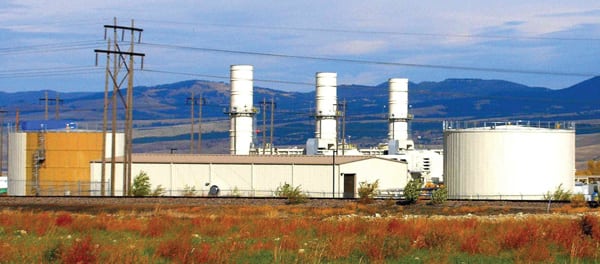 |
| 1. Regulating reserve plant. NorthWestern Energy’s Dave Gates Generating Station consists of three Pratt & Whitney Power Systems 50-MW Swiftpacs. Also shown is the 500,000-gallon raw water storage tank on the right and the 500,000-gallon demineralized water storage tank on the left. Courtesy: NorthWestern Energy |
Defining the Need
NWE is an electric and natural gas utility that serves approximately 656,000 customers in the western two-thirds of Montana, eastern South Dakota, and central Nebraska. The company is headquartered in Sioux Falls, S.D.; its Montana general office is located in Butte.
In 1997, the Montana legislature enacted Senate Bill 390 (SB 390), the Electric Utility Industry Restructuring and Customer Choice Act, to deregulate the state’s electricity markets. To promote development of merchant generation, SB 390 required Montana Power Co. (MPC) to functionally separate its generation resources from its transmission and distribution (T&D) assets. MPC sold its generating capacity to PPL Montana in 1999, and NWE acquired MPC’s remaining T&D assets in 2002. At that time, NWE did not own any generation assets in Montana, so it relied on contracted power purchases from outside its service territory. By 2005, quickly rising power prices caught the attention of the Montana Public Service Commission and state legislators.
The Montana legislature passed House Bill 25 (HB 25) in May 2007, which allowed NWE to build and add new generation to its rate base as part of the state’s move back toward the regulated utility model. Also in 2007, NWE was faced with two problems that threatened its grid-balancing authority responsibilities: Purchased ancillary services were becoming more costly, and renewal of those contracts was just a few years away.
A self-assessment found that NWE’s most important generation need was not baseload or peaking power, but regulating reserve power. The Shaw Group was retained to perform an independent engineering assessment of technology and plant siting options for a plant designed to provide regulating services to NWE’s Montana grid.
Shaw completed site and technology recommendations in December 2007. The generation technology options were quickly narrowed to fast-acting natural gas–fired, simple cycle combustion turbines (CTs). The turbine selection process began in January 2008 and ended in July 2008 when an agreement was reached with Pratt & Whitney Power Systems (PWPS) for three Swiftpacs, based on the FT8 combustion turbine (Figure 2). In addition, Shaw was retained as the owner’s engineer for the project in the fall of 2008.
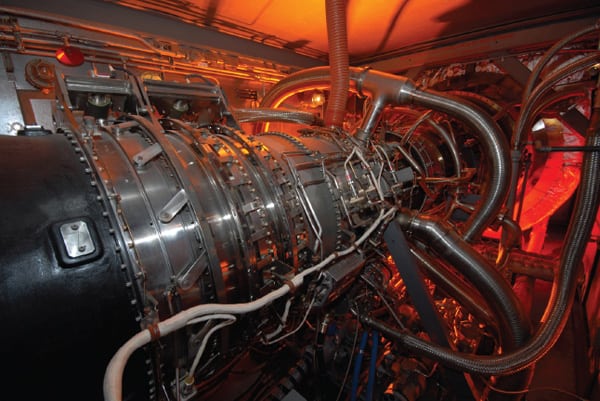 |
| 2. The race goes to the swift. A close-up of the Pratt & Whitney Power Systems FT8 combustion turbine inside the enclosure shows how the output shaft on the right connects with a double-ended generator. Another FT8 is attached to the other side of the generator. The entire package is a 50-MW Swiftpac. Courtesy: Pratt & Whitney Power Systems |
Supplying Regulating Services
Unlike other regional grid-balancing authorities (a transmission system operator responsible for balancing electricity supply with system demand at all times to meet strict transmission system operating and reliability requirements), NWE operated its transmission control area in western and central Montana without the benefit of owning or operating company-owned generation. Consequently, before building DGGS, NWE relied on several short-term contracts for balancing power, also called ancillary services, to balance on a moment-to-moment basis the differences between scheduled electric supply and demand within its assigned region.
The instantaneous measure of this balance is known as the Area Control Error (ACE), which is calculated every 4 seconds. The Control Performance Standards are a measure of how well NWE manages its ACE. Generally, NWE’s main focus is to manage the magnitude of the ACE within prescribed limits.
Design requirements for grid regulation are stringent because grid balancing requires a plant to rapidly and continuously change load, usually within seconds to minutes. Demands on ancillary service providers in areas, like Montana, with growing amounts of nondispatchable generation are expected to grow.
Nondispatchable resources for NWE include about 150 MW of wind plus small roof-top photovoltaic systems that are net metered. Because wind is very difficult to accurately schedule and can be highly volatile on a moment-to-moment basis, it is difficult to integrate into the transmission grid. For example, generation from the Judith Gap Wind Farm in south central Montana frequently ramps up from 0 MW to 131 MW in 10 minutes and ramps back down to 0 MW in the same length of time. DGGS was sized and designed to accommodate load changes of this magnitude and speed.
Combustion Turbine Requirements
The technology assessment completed by Shaw considered a wide range of generating options for providing electrical transmission system regulating service. The PWPS FT8 natural gas–fired CT was the logical selection because of its many advantages, outlined below.
High Availability. Regulation service is needed continually on the transmission system, so high availability is necessary.
Rapid Ramp Rate. The generating equipment must quickly respond to variations in system generation and system load. NWE’s system needs were an aggregate ramp rate of 30 MW/minute.
Maximum Unit Turndown. A low minimum load keeps the offset of relatively inexpensive baseload power to a minimum yet positions the plant to immediately respond to system disturbances. Each of the three 50-MW rated Swiftpacs consist of two CTs driving a single, double-ended generator. Maximum turndown is achieved with one of the two CTs operating at about 3.5 MW.
Right-Sized Regulation. The size of the plant will meet existing regulation capacity requirements, estimated at 127 MW in 2015. The projected increase in wind generation is relatively large compared to existing system load. The 3 x 50-MW Swiftpac plant will provide the regulation response and capacity needed for the system for the near term. DGGS has provisions for a fourth unit, if needed.
Quick Construction. The plant had to be constructed quickly to reduce NWE’s future market risk related to grid reliability, cost of contracted regulation service, and contract renewal dates.
Secondary Fuel Option. To avoid costly upgrades to the gas transmission system, gas supply to the plant can be interrupted in the cold extremes of winter, when gas demand is high. On-site storage for ultra-low-sulfur diesel fuel allows continuous operation during periods when gas is not available. The ability to use alternative liquid fuel improves the general reliability of plant operations.
Regulatory Details
As part of the original project assessment, NWE identified a dozen potential sites in Montana where the plant could be located. Shaw developed a matrix of important siting parameters, such as availability of natural gas, transmission congestion, land use, and other similar factors. A first cut reduced the dozen sites to a final four. A more definitive list of 35 selection criteria was then developed to assess the four sites. The final analysis indicated that the best site was at Mill Creek in southwestern Montana outside of Anaconda. This site had minimal electrical congestion and was near an existing substation and a main natural gas trunk line. The site was an existing brown field—specifically, a Superfund site—so permitting and land use issues were minimized as long as the site was properly remediated prior to construction.
The application for approval to construct the plant was filed with the Montana Public Service Commision (MPSC) in August 2008. A provision of HB 25 allowed the MPSC up to 270 days after receipt of an adequate application to issue a decision, with the option of an additional 90 days. If an air quality permit is required, MPSC is required to hold a public hearing on the application at least 30 days following the issuance of an air permit. These published regulatory lead times did not match well with the practical need to have the plant in service by the time contracts with third-party ancillary service providers expired. The first MPSC hearings were held in February 2009 and, despite several interveners, the MPSC granted project approval in May 2009.
In addition, an application for an air quality permit was filed with the Montana Department of Environmental Quality (MDEQ) in August 2008. The MDEQ required additional air dispersion modeling that was completed three months later. The final, complete application was submitted on Dec. 1, 2008. The MDEQ approved the permit in January 2009. The air quality permit includes the future, fourth unit.
Construction Plan
While the regulatory process continued, the selection of the engineer, procure, and construct (EPC) contractor continued. Fifteen pre-bid qualification inquiries were sent out in October 2008. Seven bidders were invited for a formal presentation, and four bidders were then selected to submit proposals. Those proposals were received on February 20, 2009, concurrently with the MPSC hearings. NewMech, a Corval Group company, was selected as the project EPC contractor. NewMech subcontracted the engineering work to Zachry. A full project release was contingent on the MPSC approval. MPSC issued a final order on May 19, 2009, allowing the project to go forward.
The form of the EPC contract was a guaranteed maximum price (GMP), excluding change orders. As part of its owner’s engineer responsibilities, Shaw instituted a robust change order review process to ensure that added project costs were closely managed. On the upside, if NewMech brought the project in for less than the GMP, then the contractor shared in 50% of the difference between actual cost and the GMP. The project was brought in under budget, which resulted in a split in the savings.
DGGS was designed to be constructed in two stages. The first phase entailed installation of the three Swiftpacs by the end of 2010 (Figure 3). The second and future phase is the addition of a fourth Swiftpac, which could occur between 2012 and 2015, depending upon NWE’s need for additional regulation service in Montana.
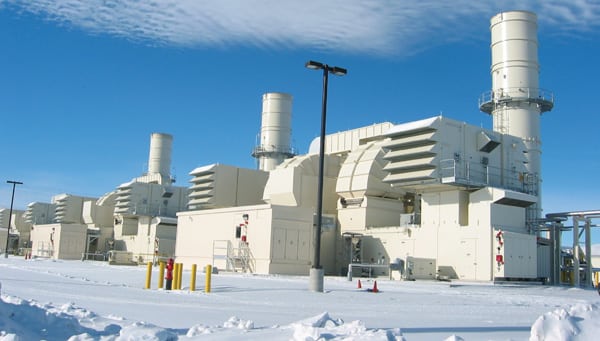 |
| 3. New Year, new start. This photograph was taken on January 1, 2011, the day that DGGS entered commercial service. The louvered boxes on the package are the air inlet filters, one for each of the two combustion turbines that constitute a Swiftpac. Courtesy: NorthWestern Energy |
Resource Sourcing
Natural gas to fire the CTs was obtained from an existing NWE pipeline running between Morel, which is about a mile north of Warm Springs, and Anaconda. A new 24-inch natural gas pipeline, approximately 2.5 miles long, connected the plant with the pipeline. To control pressure in the pipeline, a compressor station, using three, 1,100-horsepower compressors, was located about 2.5 miles from the facility near State Highway 48.
The fuel gas line to the plant also has an important second use: It is designed to provide instantaneous storage (line packing) in order to respond to rapid changes in gas demand caused by the CTs responding to grid regulation needs.
Water for DGGS is sourced from the Silver Lake pipeline, a 34-inch-diameter line that carries water from areas west of Anaconda to Butte. The pipeline crosses the southern end of NWE’s property. Only 600 feet of small-diameter pipeline was needed to bring water into the plant, where it is stored in a 500,000-gallon raw water storage tank.
From that storage tank, water is filtered in multimedia filters and then sent through cartridge filters before entering the reverse osmosis unit to remove dissolved minerals. The reverse osmosis effluent is further processed through an electro-deionization skid to meet the water injection purity requirements of the combustion turbine manufacturer and then stored in a second 500,000-gallon demineralized water storage tank. The water injection flow rate to each CT for NOx control is approximately 26 gpm. Wastewater produced at the plant is primarily reverse osmosis reject water that is transported to the City of Anaconda’s wastewater treatment plant via a 2-mile-long sewer line (Figure 4).
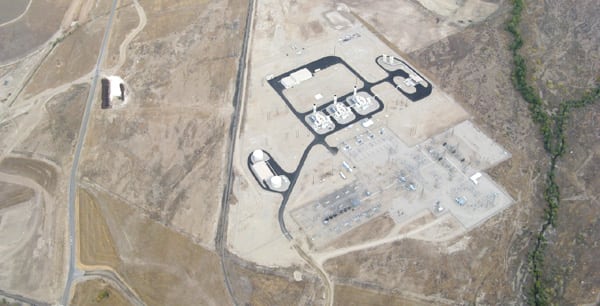 |
| 4. High plains plant. The three Swiftpacs are located in the center of the plant site, each with a single, 90-foot-tall stack, approximately 15 feet in diameter. The gas compression building is in the center, and the back-up diesel storage tanks, the ammonia storage system, and the fuel transfer building are on the right. The water treatment building and water storage tanks are on the left. Courtesy: NorthWestern Energy |
Unique Air Quality Permits
The emissions control system for DGGS was “atypical” Best Available Control Technology (BACT) in its analyses and determinations. Typical BACT analyses define an emission limit based on the historic best control technology and emission rates associated with steady state operation. DGGS, however, was designed to operate in a highly fluctuating power generation mode to balance the grid. A change in the standard BACT analyses and compliance testing methods was required.
Bison Engineering, located in Helena, Mont., prepared the air permit. Given the very tight schedule for the project, the most stringent yet proven air quality control systems were proposed as BACT for this installation: water injection and a selective catalytic reduction system for NOx control, and catalytic oxidizers for carbon monoxide (CO), volatile organic compounds (VOC), and particulate matter (PM2.5) control, based on fuel selection (natural gas). With the best control methods proposed in the air permit application, the remaining question was what to propose as practical emission limits, given the units’ unusual operation regime. Estimated fuel consumption for the plant is 3,500 million standard cubic feet per year of natural gas and approximately two million gallons per year of ultra-low-sulfur fuel oil.
The levels of NOx and PM produced by a typical CT are a function of turbine load, but those of CO and VOC are not. At this plant, emissions of CO and VOC were found to vary significantly over its operating regime. For example, as turbine load increases, mass flow rates of pollutants increase, yet the concentration of those pollutants drops. Conversely, as the turbine load drops, mass flow rate drops, but concentration increases. The concentration of emissions varies as the turbine load changes, yet the maximum mass emissions do not necessarily occur at maximum generation and turbine loads.
An analysis incorporating these and other site and operating variables resulted in annual emissions (concentration and mass rate) estimates for more than 30 possible operating scenarios. To determine the most likely annual plant emissions, a probability distribution was assigned to the 30 scenarios, also based on three years of site ambient temperature measurements. A conservative analysis of the mathematical simulations using these probability distributions determined that the plant was not required to obtain a Prevention of Significant Deterioration permit.
NWE proposed BACT emission rates at the peak values found during operating simulations, irrespective of maximum generation capacity. NWE requested as long an averaging period as possible, to account for periodic non–steady state operations. As emissions vary greatly between fuels, BACT emission rates are fuel dependent. Originally, NWE proposed a concentration-based BACT rate, as PWPS could guarantee a fairly constant emission rate across most operational loads, down to approximately 6% of maximum turbine load. In order to provide the emissions guarantees at the low turbine loads, the turbine vendor provided a slight derate in emissions reduction at maximum generation. This derate provided predictable water injection control and flame stability at the low loads the turbines would typically experience at DGGS.
The application for the air quality permit was submitted in August of 2008 with emission rates approximately two to four times higher than current BACT levels for aeroderivative turbines operating at steady state. NOx and CO were proposed as concentrations (ppm) as a reasonable assurance that the plant was meeting BACT at all operational loads, including low turbine loads. Thirty-day averages were proposed on all pollutants; PWPS was also willing to guarantee the emissions on an hourly basis.
The MDEQ requested that modeling of PM2.5 be expanded to include additional sources, most of which had never been modeled or fully inventoried before. The models, which included nine years of meteorological data, were modified to include more than 300 additional sources. The new models were then run several dozen times, each run requiring more than 400 computing hours. Several months were required to develop the inventories, rerun all modeling, and modify the application.
The revised application was resubmitted in December 2008 and was determined administratively complete. The final air quality permit was issued on Jan. 22, 2009, in support of the MPSC hearings in February 2009.
Offsetting Carbon Emissions
One of the more unique provisions of HB 25 is the requirement that a utility generating electricity from a new facility using synthetic or natural gas offset its carbon dioxide (CO2) emissions by implementing “cost effective carbon offsets.” Cost effective carbon offsets are defined as “any combination of certified actions that are taken to reduce carbon dioxide emissions or that increase the absorptions of carbon dioxide, which collectively do not increase the cost of electricity produced annually on a per-megawatt-hour basis by more than 2.5%.”
Unlike other carbon offset programs, Montana’s law does not require offsetting a quantity of CO2. Instead, the statute requires spending a sum of money, to be determined by the MPSC, for offset activities. NWE elected to implement the carbon offset requirement through a grant program, making funds available to third-party providers who will implement the programs. Possible program types in which the investment can be made include agriculture and forestry (such as tree planting and reforestation), general conservation (adding parks within 25 miles of the plant, funding conservation easements, or permanently protecting lands that support critical wildlife species), and energy conservation (building energy efficiency and other energy loss–reduction projects).
A request for proposals from carbon-offset providers was circulated in the spring of 2010. The 26 applications received were evaluated by an advisory council consisting of representatives from MPSC, the conservation community, and NWE. A project priority list and recommendations for funds was submitted to the PSC for a final decision. A compliance hearing with the MPSC is scheduled for November, during which carbon offsets will be discussed. The final decision is pending with the MPSC.
Third-Party Operator
When its plants were sold to PPL Montana in 1999, most of NWE’s expertise in plant operation was lost. Because the May 2009 MPSC order approving DGGS required NWE to operate the plant with its own personnel after three years, in early 2009, NWE solicited bids from three third-party operators. NAES was selected in June 2009, and the plant operations contract was in place by the end of 2010. Having the plant operator on board early was helpful during discussions with the potential CT and other major equipment suppliers regarding plant operations and spare parts inventory needs.
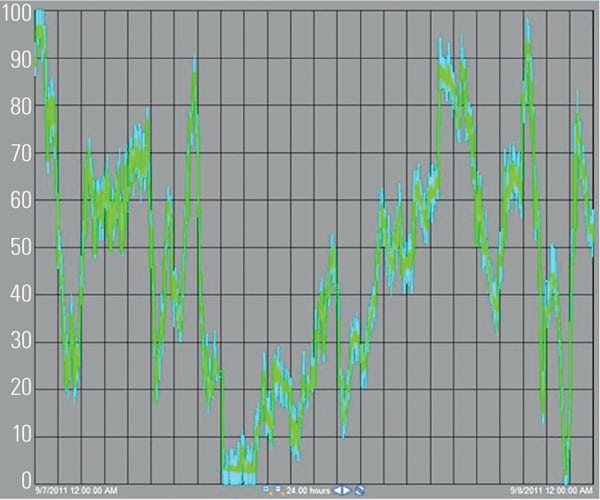 |
| 5. Follow the leader. This figure shows the automatic generation control (AGC) signal requested from NorthWestern Energy’s System Operations Control Center (pale blue line) and the output from Dave Gates Generating Station following that signal (green line) over a typical 24-hour weekday. Engines are started and stopped as required to follow the AGC signal. The vertical scale is 100 MW, maximum. Wind power capacity of 150 MW is connected to this system. Courtesy: NorthWestern Energy |
As of September 30, 2011, the six engines at the DGGS have operated 16,488 hours, producing approximately 251,000 MWh net. Two-unit availability has been 99.38%, which provides sufficient regulation capacity except in extreme temperature conditions when three units are needed. An impressive 5,465 engine starts have occurred since commercial operation. The plant has served as a reliable replacement for third-party contracts for regulation service by consistently meeting a monthly control performance standard (CPS2) greater than 90%, the required reliability standard (Figure 5, p. 60).
— William T. Rhoads, PE ([email protected]) is general manager, generation; Dr. John S. Fitzpatrick ([email protected]) is executive director, state and local community relations; and Richard P. Walsh ([email protected]) is environmental manager, large projects for NorthWestern Energy. Gary T. Wiseman, PE ([email protected]) is a project manager for The Shaw Group.